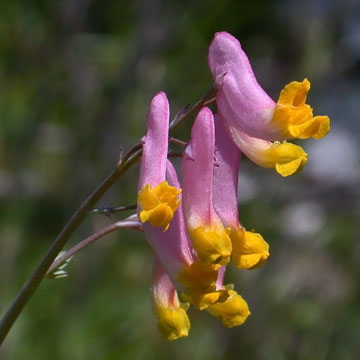

Capnoides sempervirens - (image 1 of 5)
Taxonomy
Family: Papaveraceae
Synonymous with Corydalis sempervirens (L.) Pers.
Habitat
Dry, rocky or sandy woods and open areas.
Associates
Distribution
Newfoundland to AK, south to NY, PA, northern IN, MN, MT, and British Columbia, and along the mountains to GA.
Morphology
Biennial or annual, glaucous; stems 30-80 cm, much-branched at least above; lower leaves petiolate, the upper subsessile; flowers in small panicles at the ends of branches; bracts minute, lanceolate; corollas (10-)12-17 mm including the spur, rose to pink-purple or greenish-purple, yellow at the apex; spur 2.5-5 mm; sepals broadly ovate, 2-4 mm; fruit erect, 2.5-4(-5) cm; seeds about 1 mm wide, with an obtuse margins.
Notes
Flowers May to September
Wetland indicator: NA
Typically forming a rosette in the late summer or fall of the first year and blooming in the spring and early summer of the second, but sometimes seeds germinating in the spring will bloom in the summer to fall. Easily grown in a well-drained soil without competition from other plants.
References
Gleason, Henry A. and A. Cronquist. 1991. Manual of Vascular Plants of
Northeastern United States and Adjacent Canada. Second Ed.
The New York Botanical Garden. Bronx, NY
|
Michael Hough © 2018 |